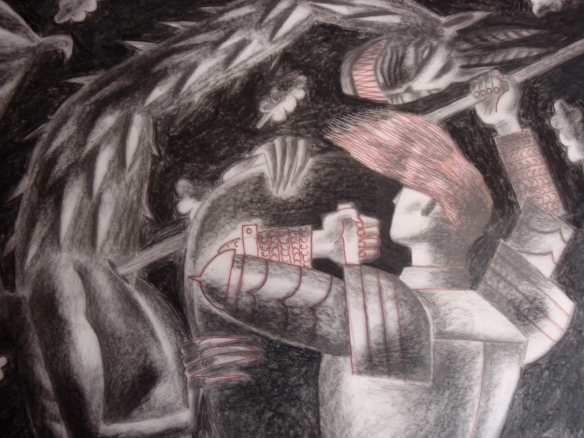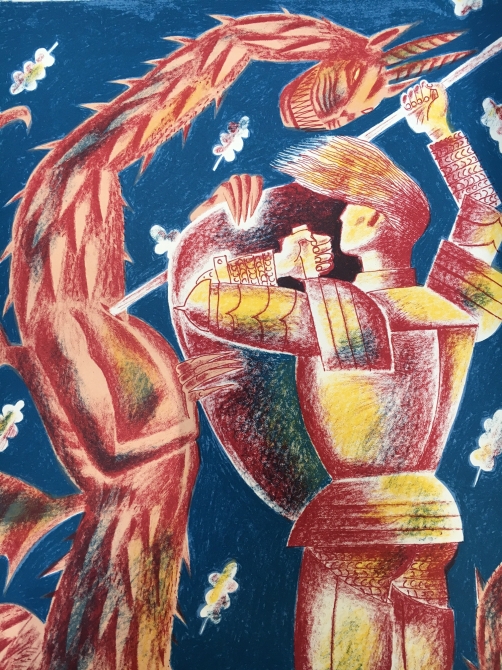I had a choice of encounters to explore visually. In the poem, while on his journey to find the ‘Green Chapel’, Gawain battles and vanquishes various creatures, including wolves, ogres, serpents and woodwoses. Woodwoses are ‘wild men’, shown as shaggy of body in early manuscripts, often wearing garlands of leaves to bind their snaky hair.
Below: Woodwose from the Speculum Regale (King’s Mirror).

I came close to showing Gawain locked in combat with a woodwose. I liked the idea of rendering all that shaggy fur.
Below: early sketch of Gawain disabling a club-wielding woodwose .

But in the end I decided that the composition would benefit from a non-human form. I’d already explored a man in combat with a dragon in a series on the theme of Saint George, and so I returned to a composition devised for Battle Ground, made in 2007.

In Battle Ground Saint George is in the dragon’s grip. By contrast in The Travails Gawain stands poised, shield raised for protection and his right arm thrusting home the killing blow. It’s an hieratic image, full of tension but not in any way, despite Gawain’s windblown hair, kinetic. I wanted the sense of a frozen moment.


Once the composition was established, I began working on a detailed drawing to guide the painting. I brought out the dragon maquettes made originally as compositional aids for Battle Ground .


Below: the finished painting of The Travails.

Work begins on rendering Gawain and the dragon in lithography crayon, ink and paint on layers of transparent plastic. These are called ‘stencils’, though that’s a bit misleading because there’s no cutting involved as there would be with the kind of stencils you might use to decorate walls or furniture.
Each layer of these screenprinting stencils represents a single colour for the eventual printing process. The sheets are fixed with registration pins over a ‘master drawing’ that guides me as I build the image.





As the layers of of the drawings increase, the image darkens.


Once the layers have been completed, they’re dispatched to the Penfold Press where Daniel Bugg processes them into screens for printing. The screens are made of micro-fine mesh stretched over frames. The mesh is coated with photo-sensitive emulsion that allows my drawings to be ‘fixed’ in such a way that when ink is squeezed through the screen, it prints the image onto the underlying paper. Each colour requires a separate screen.
Once Dan has the screens prepared he mixes colours and the process of printing and proofing begins. This is the point at which we get a sense of whether I need to do further work on the existing stencils. If required I add new ones. We make decisions on how to manipulate the layers of colour to achieve the desired effects. For The Travails many proofs were made, some of them transforming the image quite radically from the original painting.
Below: early stages of proofing.


Below: At this stage, Dan points out that I’ve forgotten to make a layer of gold for the falling leaves. The background is darker than in my painting, but the fact is that the intention is to make a printed image with qualities in its own right and not a reproduction of the painting. The painting is really just the starting point of a new creation through the medium of the screenprint.

Below: a brighter blue for the background better approximates the original painting, but is nevertheless unsatisfactory. The colour of the dragon too, gets closer to the original, though we both agree it has too much of a resemblance to chewing-gum.

Dan and I reference the painting (below) throughout the early stages of the printmaking, though we quickly realise that the background blue and the colours of the dragon and Gawain are too tonally alike for the combination to work as intensely as I want for the screenprint.

Below: Dan tries a more radical approach. The background darkens and the dragon turns the colour of a plum. I like this one a lot, though we feel that the dragon and Gawain need to be closer in tonal value in order to better balance the composition. Gawain is catching the eye too much.

Below: Dan has added a layer of texture to the dragon using a stencil I’d made for another print. The background has become even inkier and Gawain’s red is really popping. The outline of the dragon is crisp. We’re both satisfied. This is the final proof, the one on which the edition will be based.

Curator and art commentator James Russell writes of the print:
Armoured but helmetless, his shield held staunchly before him, Gawain plunges his spear into the breast of a serpent. Fans of Clive’s work may recognise the grinning beast with its ghastly scaled body as a relative of the dragon battled by St George in a memorable series of paintings, but this is a different kind of image for a different kind of story. The tale of St George would have been familiar to the Pearl Poet’s original audience, as would a host of quest narratives and stories of bravery in which the slaying of a dragon or similar beast represented a culmination. Victory proved the knight’s valour and therefore his moral worth. Not so in the case of Gawain.
In one short if vivid passage we learn of his journey in search of the Green Knight’s home, the Green Chapel, in which he vanquishes a menagerie of medieval monsters. Wolves, bears, giants, woodwoses, serpents… none can match him. He proves his strength and courage again and again, but these battles are little more than ritual acts. The world has moved on, and when he undergoes his true test he will not even know he is being tested.
In portraying St George, Clive presented the sinuous form of the dragon and the limbs of the knight twisting together in violent struggle, but Gawain is not wrestling this beast. He is dispatching it, calmly and resolutely. Is it his virtuous shield with the painting of Mary that empowers him? Or is he simply too strong for mere serpents? Or are these easy victories set up for him, to inflate his pride? The falling oak leaves suggest that we are already within the Green Knight’s domain…
James Russell
…
Gawain and the Green Knight: Clive Hicks-Jenkins and the Penfold Press opens at the Martin Tinney Gallery, Cardiff, on Thursday 8th Sept. The exhibition runs until October 1st.
…

I really love this dragon, the torso is so human, and the length of neck and tail make it so strange… It’s a fantastic, terrifying creature!! Wonderful! And thank you so much for all these steps of the process!!
This is fabulous – to see the screen print in different stages of development and proofing is a rare treat. Thank you. Husb and I are coming to the PV so see you on Thursday 😀
Seek me out, look me in the eye and shake me by the shoulders to bring me back into the land of the living, repeatedly intoning your name while doing so. Private views terrify me so much that I go into ‘Anaesthetised Zombie Mode’!
Before PVs, I do about half an hour of Tai Chi breathing and a lot of motivational quotations. By motivational quotations I mean the Malcolm Tucker motivational quotations 😉 Please don’t click on it if you are offended by absolutely filthy language https://www.buzzfeed.com/robinedds/dont-ever-call-me-f-in-english-again?utm_term=.jiBjPDRwrN#.gew7jloKLB
Sadly (and terribly frustratingly!) we can’t get to the PV either. I do want to say, Clive, that it has been remarkable watching all this work in progress AND extraordinarily generous of you to give up time to actually doing the Artlog at the same time and answering all the queries and comments. You really are a marvellous, kind and inspiring person…thank you xx
Always so enjoyable to see such complete photo documentation. Wish I could see the exhibit, but will admire it from afar!
Fascinating to see how this is created. Thank you for explaining and showing this process so clearly!
My pleasure, Lorrie.
Enjoy your holiday.
Very interesting thanks Clive. I guess you went through many heart stopping moments during this process! Hope the exhibition goes wellxxxxL
Feeling such relief, Liz, having got all the work to MTG ready for the hang and Private View next week. I’ve been a terrible old hermit for the past months, just totally concentrated on the job in hand. I promise I’ll be a better friend and correspondent now the pressure is off. Sending love to you and G. xxxxxxx
No-one could be a better friend than you, dear Clive, you mustn’t feel pressurised into that as well! Love as always to you bothxxxxL